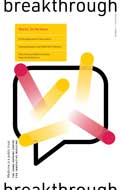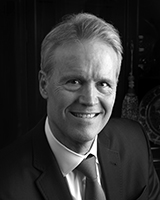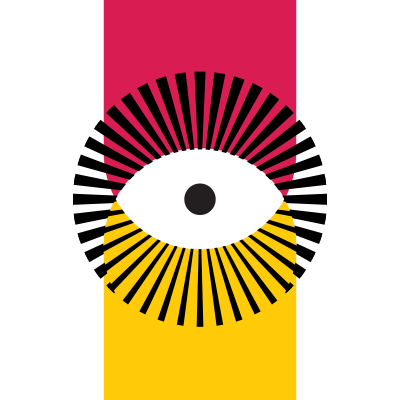

David B. Hellmann,
MD, MACP
As I was reading over the stories in this issue of Breakthrough, the name of a currently popular movie came to mind: Everything Everywhere All at Once. The all-encompassing nature of the title of this award-winning film is an apt descriptor, I believe, of the incredibly far-reaching, broad-ranging efforts that so many CIM faculty and trainees are engaged in to advance the work of CIM’s Initiative for Humanizing Medicine.
Consider the work of physician/bioethicist Mary Catherine Beach, for example, who is co-founder of the Initiative for Humanizing Medicine and the Mary and David Gallo CIM Scholar, whose research focuses on how respect and communication play out between patients and clinicians. She’s found that the language doctors use in patient medical records can stigmatize patients, impacting future care and perpetuating health inequities. As you’ll read on p. 2, Mary Catherine has emerged as a national leader in addressing this issue.
You’ll also learn about the work of two CIM-affiliated physicians — one a rising star, the other an established international expert — who are both pushing exciting advances to improve the lives of countless patients. Michelle Sharp, a Mary and David Gallo Scholar, has her sights on improving care and treatment for sarcoidosis, a difficult-to-diagnose condition that can impact virtually every organ in the body (p. 8). Constantine Lyketsos, the Alafouzos CIM Scholar and a world-renowned leader in Alzheimer’s disease care and research, is leading promising precision medicine solutions to dementia — solutions using stem cell technology that could be targeted “to reach the right patient at the right time with the right treatment,” as he describes on p. 16.
Of course, giving the next generation of physicians the tools they need to get to know patients as people is crucial. Toward that end, we share the story of Osler medical resident Amol Gupta, and his Medicine Mentors Podcast and a spin-off Personomics podcast, which are both aimed at medical trainees (p. 14). And I think you will be particularly intrigued by the efforts of psychiatrist Meg Chisolm. A member of the Miller Coulson Academy of Clinical Excellence, Meg is a passionate leader in art museum-based medical education, which, as she explains on p. 18, can prepare doctors who are better equipped to deliver humanized care.
There’s more, much more, in this Breakthrough, so I invite you to read it from cover to cover. And I’ll end with a big thank-you. Without your generous support, we would not be able to mount such ambitious, impactful projects — Everything Everywhere All at Once —that have the potential to transform the very future of health care.

David B. Hellmann, M.D., M.A.C.P.
Aliki Perroti Professor of Medicine
Don Willett May 5th, 2023
Posted In:

David B. Hellmann,
MD, MACP
As I was reading over the stories in this issue of Breakthrough, the name of a currently popular movie came to mind: Everything Everywhere All at Once. The all-encompassing nature of the title of this award-winning film is an apt descriptor, I believe, of the incredibly far-reaching, broad-ranging efforts that so many CIM faculty and trainees are engaged in to advance the work of CIM’s Initiative for Humanizing Medicine.
Consider the work of physician/bioethicist Mary Catherine Beach, for example, who is co-founder of the Initiative for Humanizing Medicine and the Mary and David Gallo CIM Scholar, whose research focuses on how respect and communication play out between patients and clinicians. She’s found that the language doctors use in patient medical records can stigmatize patients, impacting future care and perpetuating health inequities. As you’ll read on p. 2, Mary Catherine has emerged as a national leader in addressing this issue.
You’ll also learn about the work of two CIM-affiliated physicians — one a rising star, the other an established international expert — who are both pushing exciting advances to improve the lives of countless patients. Michelle Sharp, a Mary and David Gallo Scholar, has her sights on improving care and treatment for sarcoidosis, a difficult-to-diagnose condition that can impact virtually every organ in the body (p. 8). Constantine Lyketsos, the Alafouzos CIM Scholar and a world-renowned leader in Alzheimer’s disease care and research, is leading promising precision medicine solutions to dementia — solutions using stem cell technology that could be targeted “to reach the right patient at the right time with the right treatment,” as he describes on p. 16.
Of course, giving the next generation of physicians the tools they need to get to know patients as people is crucial. Toward that end, we share the story of Osler medical resident Amol Gupta, and his Medicine Mentors Podcast and a spin-off Personomics podcast, which are both aimed at medical trainees (p. 14). And I think you will be particularly intrigued by the efforts of psychiatrist Meg Chisolm. A member of the Miller Coulson Academy of Clinical Excellence, Meg is a passionate leader in art museum-based medical education, which, as she explains on p. 18, can prepare doctors who are better equipped to deliver humanized care.
There’s more, much more, in this Breakthrough, so I invite you to read it from cover to cover. And I’ll end with a big thank-you. Without your generous support, we would not be able to mount such ambitious, impactful projects — Everything Everywhere All at Once —that have the potential to transform the very future of health care.

David B. Hellmann, M.D., M.A.C.P.
Aliki Perroti Professor of Medicine
Don Willett May 5th, 2023
Posted In:

In virtually every medical visit we have with a doctor these days, the physician makes notes about the encounter — information that goes into our electronic medical record, which subsequent clinicians will read and rely upon to help shape the care they provide.
Intentionally or not, those physician notes can include negative language about our encounter — stigmatizing language that has the potential to influence the attitude and behavior of other doctors who read the notes, says Mary Catherine Beach, co-founder of CIM’s Initiative for Humanizing Medicine, whose 27-year career in medicine has focused largely on investigating how respect and communication play out between patients and clinicians, with the goal of improving care for each patient.
“I fundamentally believe that stigmatizing language is dehumanizing. It devalues people,” says Beach, a Mary and David Gallo CIM Scholar. “And when negative language is used in a patient’s medical record, it has the potential to impact future care of the patient and perpetuate health inequities.”
In a qualitative study published in JAMA Network Open, Beach and her colleagues analyzed physician notes describing 600 patient encounters at an urban academic medical center. The team found five themes representing negative language used by the doctors. Importantly, she notes, the team also arrived at six themes representing positive language.
“I fundamentally believe that stigmatizing language is dehumanizing. It devalues people. And when negative language is used in a patient’s medical record, it has the potential to impact future care of the patient and perpetuate health inequities.” – Mary Catherine Beach
In the “negative” category are notes that question a patient’s credibility (He claims that nicotine patches don’t work for him) and those that show explicit racial or class stereotyping (Reports that the bandage got “a li’l wet”). Other notes describe a difficult patient by including details of questionable clinical significance that depict the patient as belligerent, and a fourth theme shows the doctor’s disapproval, often by highlighting a patient’s poor reasoning (He was adamant that he does not have prostate cancer because “his bowels are working just fine.”) Rounding out the list is a category Beach describes as unilateral decisions. This describes paternalistic language that upholds a power dynamic where the doctor presumes authority and portrays the patient as childish or ignorant (She was told to discontinue…).
“When I present our findings to physician groups, rather than any defensiveness, I usually get a very positive response,” says Beach. “There’s often an, ‘Oh, yeah! We do write that,’” she says, adding, “‘Some of this language has been normal for so long, it didn’t hit us that it was wrong or that it could hurt people.’”
But words can hurt, she notes. Patients who have difficult interactions with the health care system are at risk of distrusting or disengaging from care. “And stigmatizing language used in the medical record compounds this problem,” she says, as the patient encounters doctors in sequence, with each doctor treating the patient in accordance with the impressions expressed by the previous physicians. In this way, negative feelings stay with the stigmatized patient. The cycle “perpetuates bias and inequitable care, further disenfranchising the patient.”
“When I present our findings to physician groups, rather than any defensiveness, I usually get a very positive response. There’s often an, ‘Oh, yeah! We do write that.’” – Mary Catherine Beach
Fortunately, Beach’s study also came with the positive findings — “language we can use to humanize our patients,” she says.
The six themes identified here include compliments (Mr. [Patient] is charming, pleasant and kind), approval (she struggled with quitting … but as of this clinic visit has quit tobacco 1 week!) and physician self-disclosure, in which the doctor shares their own positive emotions related to the patient (I am happy to continue coordinating her care).
Other positive themes: minimizing blame (she has not been taking iron because it makes her constipated); personalizing, which involves incorporating details about the patient as an individual (She enjoys walking with her fiancé and her dog named Scout); and bilateral decision-making, which references incorporating patient preferences into the treatment plan.
In the time since this study was published, “interest in our findings has just exploded,” Beach says. “I am asked every week by journal editors to serve as a reviewer for one or two other papers on stigmatizing language.” And, she’s been approached by the nation’s two major medical records providers — Epic and Cerner — to join future working groups that will study how medical documentation can be improved by identifying and removing biased language.
“By enhancing awareness around physicians’ word choice patterns and the potential consequences of those patterns,” she says, “we believe well-intentioned doctors will be motivated to improve their documentation practices.”
It’s vital work, Beach says, that has the potential to be a “game changer” in transforming health care, particularly for the nation’s most vulnerable patients.
Don Willett May 5th, 2023
Posted In:

It’s been 20 years since Johns Hopkins’ Peter Agre won the Nobel Prize in Chemistry for his game-changing discovery of aquaporin water channels. Known as “the plumbing system of cells,” aquaporins facilitate the movement of water across cell membranes and are now known to have a vital role in processes ranging from brain function to male fertility to hearing and vision.
At a recent CIM Seminar, dozens of CIM supporters and clinician-scientists gathered online with Agre, now director of the Johns Hopkins Malaria Institute and a Bloomberg Distinguished Professor, to reminisce about the exciting swirl of activity surrounding his Nobel honor and to learn insights he’s gained over the last two decades.
On the Months Leading Up to the October 2003 Announcement of his Nobel Prize
“I had been invited to lecture several times in Sweden over the previous few years,” Agre recalls. “Then out of the blue, I got an email from Bengt Nordén from Sweden asking if he could come visit me in the laboratory. This was unexpected. I didn’t know who he was, so I called a colleague, who told me: ‘You might be interested that he is chair of the Nobel Chemistry Committee.’
“His visit was very pleasant. He never talked about the Nobel Prize, and I didn’t ask him about it,” Agre says. CIM Scholar Landon King, a key member of Agre’s lab team at the time and today executive vice dean for the school of medicine, recalls that Nordén and Agre spent much of the day examining old lab notebooks, “looking for evidence of the primacy of the discovery.”
“It all became even more tantalizing when a Swedish television crew showed up in our lab on pretty short notice, with no explanation.” – Peter Agre
“It all became even more tantalizing when a Swedish television crew showed up in our lab on pretty short notice, with no explanation,” Agre says.
King adds, “We imagined it. To the point that I went out and bought bagels and balloons the night before the announcement was to come out.”
On the 5:30 am Call That Changed Everything
“On Wednesday of that first week in October, about 5:30 in the morning, the phone rang. I was ready,” Agre says. “I answered, and a pleasant voice with a Swedish accent said, ‘This is an important telephone call from Stockholm for Professor Peter Agre. Are you Professor Agre?’ I replied, ‘I sure am!’ Then they connected me with the Nobel Chemistry committee.”
Agre learned that he shared the prize in chemistry with Rockefeller University’s Roderick MacKinnon, for his work on the structural and mechanistic study of ion channels.
“I was instructed there would be a press conference in 20 minutes. I sprinted for the shower,” Agre says. “Mary, my dear wife, called my mother in Minnesota. My mother was a farm girl who was very wise in the ways of humanity. She listened to Mary and said, ‘Tell Peter that’s very nice, but don’t let this go to his head.’”
“Then Landon appeared at the door with balloons, and the New York Times was in the front yard. Johns Hopkins President William Brody called. I made my way into the lab, and by 10 o’clock in the morning, there was already a party going and champagne ripping open, and the day only got crazier.”
On Nobel Week in Stockholm, December 6–12
“It’s a very compact week with multiple events every day — lectures by the Laureates and receptions. The ceremony itself is held in Symphony Hall in downtown Stockholm. Everyone is in formal wear: white tie and tails for men. They don’t trust the Laureates to know how to receive the award, so they actually have a practice session earlier in the day. They instruct you where to sit, where to stand, how to approach the king, how to bow.
“Following the awards ceremony, there’s a sit-down dinner for 1,100 people, served simultaneously by waiters, some of whom are opera singers, so it’s a musical performance. There’s really a lot of fanfare. During the banquet, one member of each prize is asked to give a three-minute talk. I gave a talk on science education for small children,” he says.
The celebration lasts well into the night with dancing and parties. “Then early the next morning, we had to get up for more Nobel interviews and visits.”
On Science as a Tool in Diplomacy
“Early in my career, I was very interested in international affairs and world events. I never thought I’d be a research scientist. In fact, I came to Hopkins with the idea of becoming a global health worker. When things started working in the lab so well, I stuck with it, but I thought that [eventually] I wanted to get more involved with bringing science to the public.
“I was elected president of the American Association for the Advancement of Science in 2008, which had a new Center for Science Diplomacy. When I became president, we had the first trips to Cuba, to North Korea and Iran. I made six trips with the AAAS. I even met with Fidel Castro himself, who was in his 80s. He was quite frail, but he had a very sharp mind.”
Agre also served as chair of the Committee on Human Rights of the U.S. National Academies of Sciences, Engineering, and Medicine from 2005–2007. “We were involved with seeking pardons and the release from captivity of scientists, engineers and health professionals from around the world. Between these two activities, I was really very busy.”
On the Importance of Cross-Training for Young Clinician-Scientists
“As a medical student, you learn a lot of information, but as a house officer, you really learn the diseases. I was a medical resident at Case Western Reserve, and program leaders there had adopted the Osler Medical Resident training model. That training really helped us anticipate what clinical defects would be caused by aquaporins. Clinical training also helps an individual develop good discipline. As an intern or resident, you’ve got to know the facts. There are no excuses.”
“Of course, every serendipitous observation is not going to turn out with an important answer. The challenge when you are sorting through the unexpected is to know when to pursue something and when to drop it.” – Peter Agre
On the Value of Serendipity
“The aquaporins were a clear serendipitous discovery,” Agre says. His lab had been focused on red cell membranes when his team came upon a protein fragment they couldn’t explain. “We were very interested in it because it appeared to have a shape suggesting it was a membrane channel, but red cells were not believed to have membrane channels.”
Agre consulted dozens of scientists about the mysterious protein (“It appeared to be a contaminant and had no clear functional role”) when hematologist John Parker at the University of North Carolina at Chapel Hill suggested that perhaps it could be a water channel. Agre and his team collaborated with Bill Guggino at Johns Hopkins to investigate the idea — which ultimately bore out.
“There was jubilation!” Agre says. “That experiment changed the focus of our laboratory entirely and my career as well.
“Of course, every serendipitous observation is not going to turn out with an important answer. The challenge when you are sorting through the unexpected is to know when to pursue something and when to drop it. If we had not figured out the function of the protein, we would have dropped it.”
Don Willett May 5th, 2023
Posted In:

When Charles Salisbury looks to some of the latest work coming out of the CIM-supported Human Aging Project (HAP), he can’t help but smile. Take the new headset, developed by a cross-disciplinary group of trainees.
The headset promotes the kind of deep sleep that may protect against Alzheimer’s and other physical and cognitive decline. Called InWave, it uses electroencephalography to monitor brain activity and an artificial intelligence algorithm to time the delivery of specialized sounds that enhance the kind of brain activity needed for deep sleep. With financial support from HAP and other grants, the trainees are building 20 prototypes for use in a pilot study.
“The Human Aging Project is a great way to call upon the expertise of the very best minds across Johns Hopkins — from the medical school, engineering school, nursing school, public health school and business school,” says Salisbury. “I have great expectations for it, and I believe that Dr. Jeremy Walston, director of HAP, is the ideal ringleader for the project, as both a geriatrician specializing in the challenges of aging and as someone who has a unique knack for bringing the right people together to tackle big challenges.”
Indeed, Salisbury was among the earliest supporters of the Human Aging Project, which launched in 2021 (see box), when he and his family funded Walston as a HAP Salisbury Family Scholar. “This early seed money from the Salisbury family and other donors has been crucial to the success of HAP,” says CIM Director David Hellmann. “It has allowed our researchers to embark on projects that have subsequently garnered millions of dollars in grant funding from the National Institutes of Health and other funding agencies.” The Salisbury family subsequently went on to support clinician-researchers Peter Abadir and Sean Leng as Salisbury Family CIM/HAP Scholars.
Most recently, the Salisbury Family has provided funding for a fourth HAP Scholar. Walston is currently soliciting applications for the coveted scholarship from top research scientists across Johns Hopkins.
During his nearly 25-year tenure with global investment management firm T. Rowe Price, Salisbury guided creation of the Fixed Income Division, launched two fixed income funds, and led management of the firm’s large institutional assets, pension funds and endowments. “So I have some idea of what’s involved in developing a large project and selling it, both internally and externally,” says Salisbury. “I believe Jeremy Walston, with the leadership of David Hellmann, is very well equipped to reach out across Johns Hopkins for expertise. I don’t think we can even imagine, at this point, how many areas can be pulled together.”
Don Willett May 5th, 2023
Posted In: